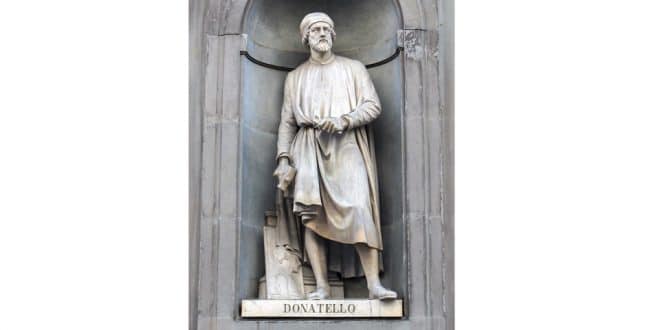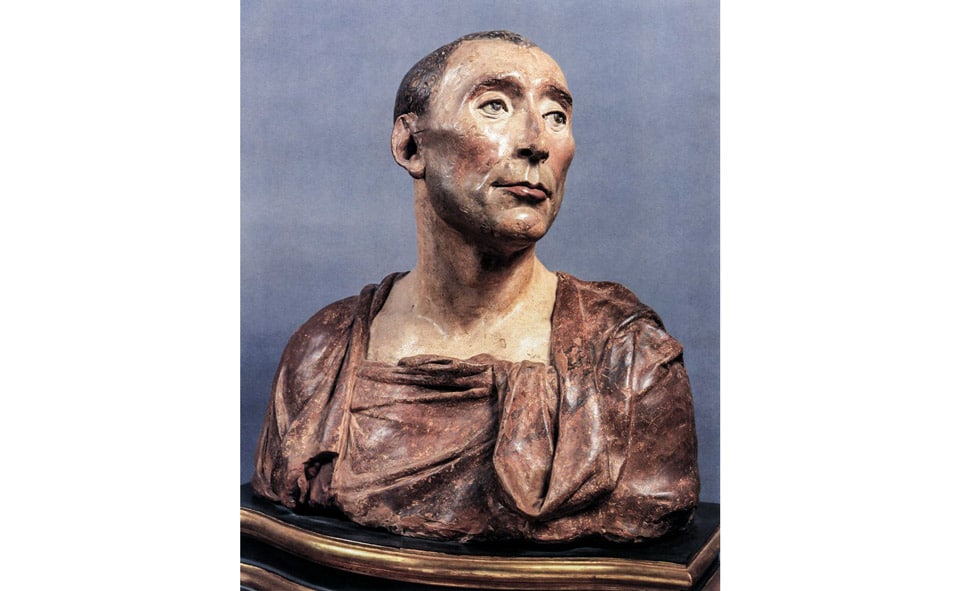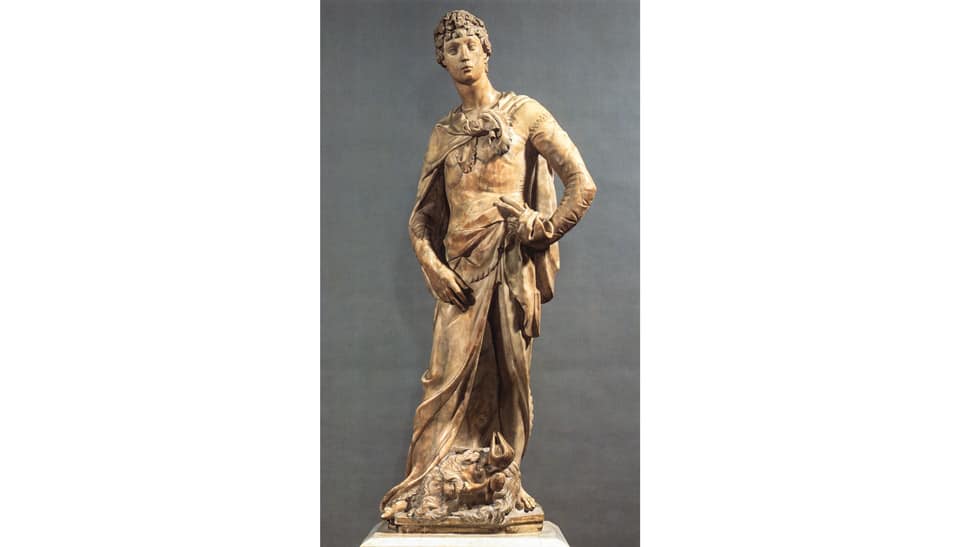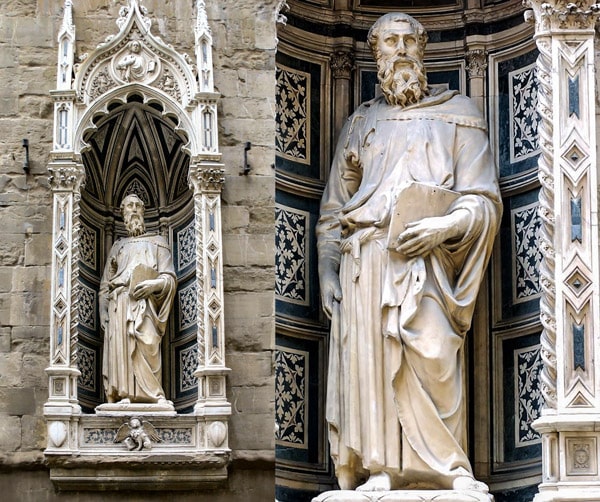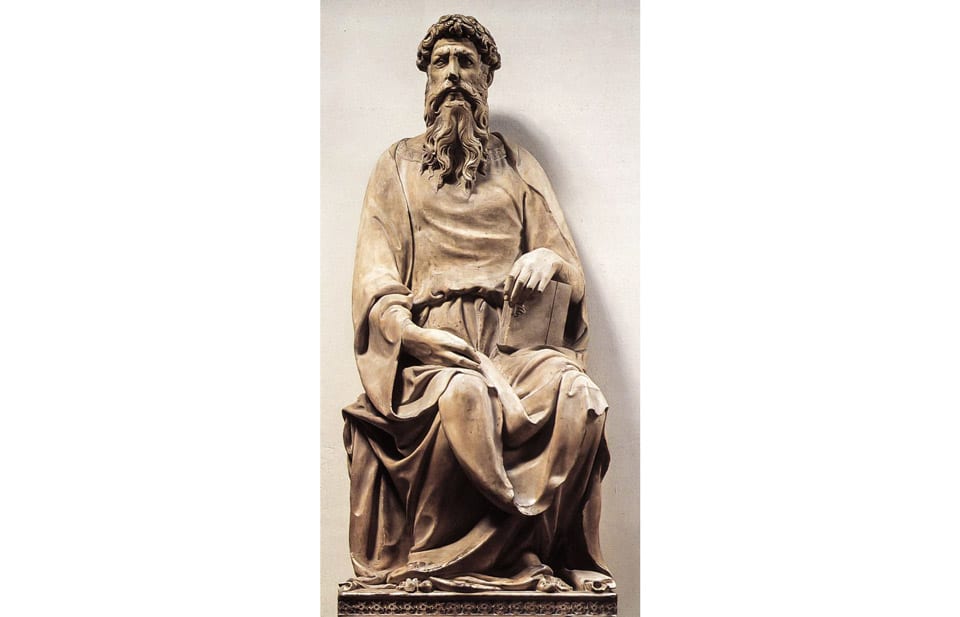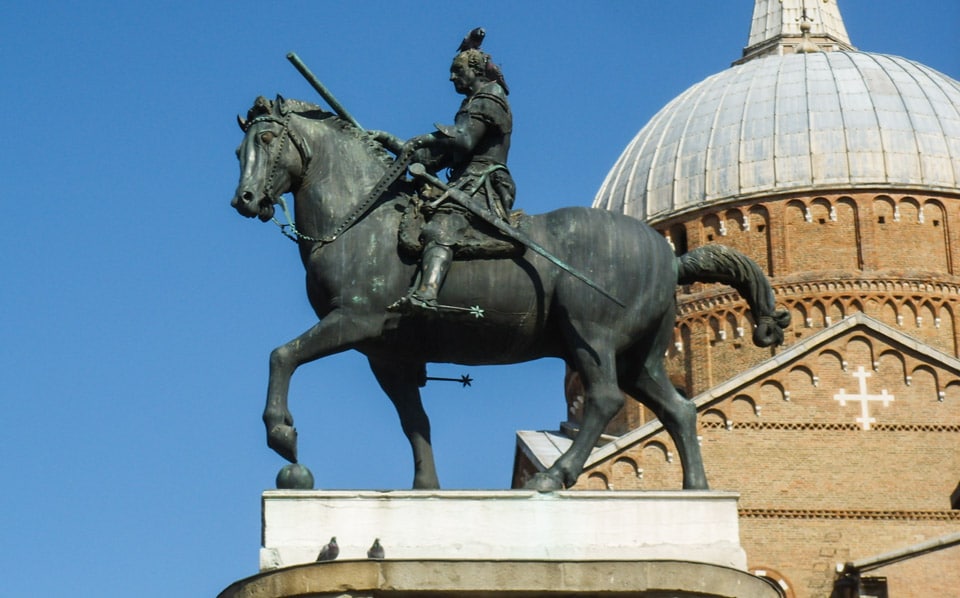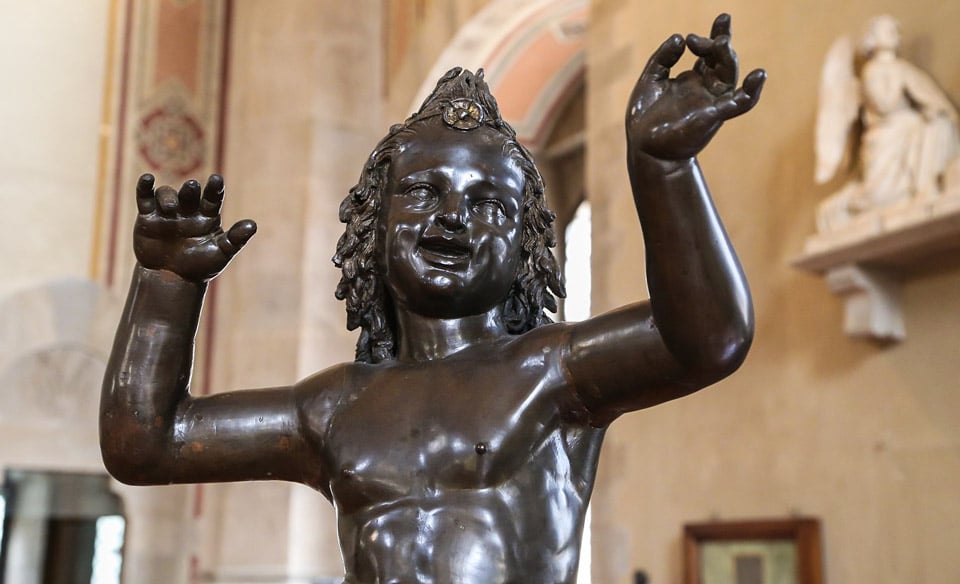The name of the Italian sculptor Donatello is inextricably linked to the early Renaissance. His work had a significant impact on the cultural heritage around the world. His works, so different from each other, are distinguished by deep meaning, energy, and perfection of form, they fascinate and remain for centuries the standard of high art.
Page Contents
Biography
Donatello (diminutive form) from Donato di Niccolo di Betto Bardi is the full name of the great painter, born in Florence, or maybe in its vicinity, roughly in 1386.
From an early age he was attracted to beauty and showed remarkable creative ability. His father was engaged in quite a profitable business in those days – the processing and production of wool, and planned to attract his son to his craft, but all attempts proved futile. The head of the family died when Donatello was still a teenager, leaving no rich inheritance.
The future great sculptor first came into contact with the world of art when he studied jewelry, in one of the workshops of Florence, owned by the famous artist and sculptor Bicci di lorenzo (Bicci di lorenzo). Here Donatello mastered the technique of bronze casting, in which many of his future independent works were made. Jewelry art in those days was closely intertwined with sculpture, architecture and painting. It was the goldsmiths who worked on the decoration of the Florentine cathedral. It is noteworthy that the training in the workshop was paid by the banker, philanthropist and patron of the young talent Martelli (Martelli).
His artistic education Donatello continued in Rome, having gone to the ancient city about 1404-1407 years, along with his best friend Filippo Brunelleschi (Filippo Brunelleschi). There his teacher was the outstanding sculptor, architect, historian, and unsurpassed master of relief works Lorenzo Ghiberti (Lorenzo Ghiberti).
His mentors were able to lay in him the main benchmarks and foundations of high art, and his natural diligence and talent allowed the birth of extraordinary works of marble, wood and bronze, which made their author famous for centuries. After returning from Rome to his native city the young master began to receive many orders from influential persons, politicians and representatives of the high clergy. Very quickly the brilliant sculptor won the recognition and respect of his contemporaries.
Donatello traveled extensively: he produced his magnificent sculptures in Pisa, Siena, Rome, Padua, Venice and many other Italian cities.
Little is known of the master’s private life, he left no offspring, died in 1466, at the age of 80, finding it rather difficult financially, seriously and long illness before his death. Donatello’s body was buried with honours in the Basilica di San Lorenzo, the largest and oldest church in Florence, to the exterior and interior decoration of which the genius sculptor had been involved.
Sculpture
Donatello’s view of sculpture proved truly innovative. According to contemporaries, in the work on the statues and reliefs, the master initially used a drawing, which was then transformed into a small model of clay or wax. This is how the composition of the future work was created.
He carried out all of his work himself, employing assistants and students only to complete minor details. The finishing of the surface was done without any particular care, which created the effect of a certain incompleteness (non-finito). Great attention was paid to the subtle play of light, shadows and highlights. The distance from which the work was to be viewed was necessarily taken into account. The master’s works are filled with realism, freedom and great courage. The main innovative techniques in the sculptural creations of Donatello are considered:
- The presence of three plans in relief;
- The use of a precise knowledge of perspective in the gradation of volumes;
- Creation of the effect of movement in static figures;
- Objective regularity of proportions and forms;
- Emphasis on the transfer of the inner world and the character.
This revolutionary approach for Renaissance artists was borrowed later by many of Donatello’s students and sculptors of subsequent eras. At different periods of his work the master adhered to both classical and realistic styles.
Busts
Thanks to Donatello’s passion for individual sculptural portraits, the Renaissance revived the fashion for busts. This type of plastic, forgotten in its time, but extremely popular with the ancient Greek and Roman artists, was resurrected again. Art historians especially note the vividness, emotionality, realism and fullness of the busts of children made by Donatello – his work largely determined the vector of the development of portraiture in sculpture.
One of the first works of the artist in this genre of plastics is considered a bust of Niccolo da Uzzano, an influential Florentine banker, public and political figure, created around the 30s of the XV century. Although, some experts question the authorship of the work.
The bust is clearly traced in the classical traditions of ancient portrait sculpture. The work is made of colored clay with a porous structure. With unusual skill, the master was able to convey the energetic and resolute nature of the statesman: the sharp turn of the head, the attentive gaze, the strong chin, the strong shoulders concealed under the drapery of antique attire – every detail convincingly reveals the personality of the hero. The bust was restored in 1985 and today is part of the art collection of the Museo Nazionale del Bargello in Florence.
Tomb of John XXIII
The Tomb of Pope John XXIII (Giovanni XXIII) is a unique work that collaborated with Michelozzo di Bartolomeo and was the beginning of a long and fruitful collaboration between the two artists. The work was created around 1425-1427. The majestic design of the tomb was considered exemplary for the tomb monuments that were installed in the temples of Italy in the XV-XVI centuries.
The four-meter marble structure is divided visually into three parts; the middle one (with the sarcophagus and the bronze figure of John XXIII) was executed by Donatello. The sculptural portrait of Balthazar Cossa (Baldassarre Cossa), the pontiff’s secular name (the Catholic Church, incidentally, considered him antipope), is full of realism because it was created not on the basis of a posthumous mask, but from the master’s personal memories. The tranquil figure of the reclining high priest looks asleep and absolutely alive. You can see the tombstone in the Battisterio di San Giovanni in the Duomo di Firenze.
Marble Statue of David
This marble statue of King David dates from 1408 to 1409. Artists often interpreted the image of the biblical ruler as an old man with the wisdom of life, holding the code of laws in his hands. Donatello’s interpretation was different from the traditional vision: he depicted David as a young victorious warrior who defeated the fearsome Goliath, which to some extent represented the liberation of Florence from the pressures of Milan and Naples.
This work combines elements of classical and Gothic style. The young king, full of energy, tenacity and grace, is presented in a natural pose, his arm resting to his side holding his robes, his head decorated with an amaranth wreath, which served as a symbol of courage and bravery in antiquity. An important point: the draping of the flowing cloak does not hide the figure of the young hero, but clearly outlines its relief.
At the end of the 19th century, the statue became part of the treasury of the Museo Nazionale del Bargello in Florence.
I advise to read about: Statue of David made by Michelangelo
Bronze Statue of David
The bronze statue of David, which was produced in the 1430s or 1540s, occupies a special, very important place in the work of Donatello.
The creation of the sculptural image of a nude figure (so characteristic of the works of antiquity) was in the highest degree of innovation and revolutionary step for the Renaissance, which previously has not dared any master. In the artistic conception of Donatello’s work the classical traditions of ancient times are clearly visible. It is noteworthy that the technique of execution (casting on the smelted model) had been borrowed from the Roman and Greek masters.
The sculpture was commissioned by Cosimo di Giovanni de’ Medici, Cosimo il Vecchio – an influential banker, patron of the arts, prominent statesman, and public figure who became the unofficial ruler of Florence and was intended to personify freedom, independence, and the triumph of justice over violence and despotism.
In 1495, after the change of political power, the almost one-and-a-half-meter tall statue was removed from the garden of the Palazzo Medici Riccardi, the residence of the powerful clan, and installed on a marble column in the courtyard of the Palazzo Vecchio, where all comers could view it. In 1777, Donatello’s work entered the art collection of the Galleria degli Uffizi, today it occupies a special place among the exhibits of the National Museum of Bargello.
Today, the master’s magnificent work is also closely linked to contemporary art. In 1956 the Italian Film Academy (Accademia del Cinema Italiano) established a special annual national award (similar to the American Oscar) – the David di Donatello, awarded in different categories to the best domestic and foreign films. The honorary award is a several time smaller exact copy of the legendary sculpture. The gilded figure of David stands on a square malachite stand and eloquently testifies to the love and respect Italians have for their culture and history.
Statue of the Evangelist Mark
The sculptural depiction of Saint Mark was made by Donatello around 1411-1412, commissioned by one of Florence’s craftsmen’s workshops. The statue was intended to adorn a niche in the southern part of the church of Orsanmichele, which served both as a granary and a temple. It is noteworthy that for six centuries, Donatello’s magnificent work never left the very spot where it was originally installed.
The figure of the Evangelist Mark is characterized by tranquility and a certain dignity. Its characteristic features, according to many art historians, are considered to be stability, monumentality and proportionality of form. The plasticity of the outlines of the garment is conveyed with incredible skill. The gaze of St. Mark is filled with deep thoughtfulness, which gives his image significance and grandeur.
I suggest you read about: St. Mark’s Square in Venice
Statue of the Evangelist John
This statue of the Evangelist John the Evangelist is from Donatello’s early period and was made between 1408 and 1415 and was intended as a decoration for the Basilica di Santa Maria del Fiore in Florence. According to art historians, this sculpture by the young master concentrates a new, humanistic vision of human nature, which became a leitmotif of the Renaissance.
The monumental figure of the seated John the Theologian exudes tranquility and restrained dignity. In the courageous image of the Saint one feels firmness and strength of character. Every detail of the sculpture is carefully designed: the draping of the clothing, the powerful arms, the spiritualized face framed by thick hair and beard.
Today this wonderful work by Donatello can be seen in the Museo dell’Opera del Duomo.
Gattamelata equestrian statue
The 3-meter high equestrian statue of Erasmo da Narni, commander-in-chief of the troops of the Republic of Venice, nicknamed Gattamelata, was created in the 1430s-40s when the sculptor lived and worked in Padua.
The work on the skilful monument was commissioned by the warlord’s widow and son. In 1453 a bronze statue on an 8-meter pedestal was placed by decision of the Senate in one of the main squares of the city, opposite the Basilica Pontificia di Sant’Antonio, where Erasmo da Narni’s body was laid to rest.
According to experts, the prototype of the monument was the equestrian monument to Emperor Marcus Aurelius (II century AD) in Rome, which the young Donatello had seen during his studies. Now the original sculpture can be seen in the Capitoline Museum, and a copy is installed in the square.
Gattamelata is depicted as a valiant rider, a triumphant, sitting confidently in the saddle. The hero is dressed in Roman armor, and at the same time endowed with vivid individual features, speaking of Donatello’s talent in the art of portrait sculpture. What is admirable is the integrity of the compositional solution, the harmony of the vertical and horizontal lines, and the care taken in working out every detail. This monumental work is considered one of the most important masterpieces of Donatello’s genius.
Dancing Atys (Cupid) in bronze
This one-meter bronze statue of Cupid (104 cm), of a charming, laughing, mischievous boy with upturned arms, is unique in Donatello’s legacy: like no other work, it is entirely thematically dedicated to a subject borrowed from ancient mythology.
Historians believe the date of creation of the work not later than the 40-ies of the XV century. In art history circles the sculpture bears the conventional name of “dancing Atys (or Cupid)”, although until now it is not known precisely who was depicted by the master. What is striking is the presence of contradictory details allied to form a single image: wings behind his back and on his feet, a satyr’s tail, half-trunk pants, a flower in his hair, a bizarre belt, and snakes winding around the lower part of the figure. All these elements speak of different mythological heroes of antiquity, so the prototype of the statue could be Mercury, Perseus, Cupid, Satyr, Pan, young Hercules or Atys.
Donatello’s enigmatic work filled with childlike energy, merriment and dynamism is among the exhibits of the Museo Nazionale di Bargello.
Bronze Sculpture of the Madonna and Child
The famous bronze statue of the Madonna and Child was made during the so-called Paduan period of Donatello’s work, around 1447-1450. The sculpture, one and a half meters tall, is clearly marked by motifs of Byzantine iconography.
The figure of the Virgin Mary occupies the center of the altar of the Basilica Pontificia di Sant’Antonio di Padova and is located between Saint Francis and Saint Anthony (also made by Donatello), although the original composition was intended to be somewhat different.
Saint Mary is depicted as a fragile, exquisite maiden sitting motionless on a throne decorated with sphinx heads. She is holding the Savior in her arms, and seems even drooping from the weight of the massive crown. The young Madonna by Donatello exudes serenity and spirituality, while at the same time the folds of her cloak, thrown back carelessly, and the cherubs adorning the garment give the sculpture majesty and solemnity.
Wooden Statue of Mary Magdalene
“Impressive,” was the precise epithet used by Giorgio Vasari, the Italian master, writer, and historian, to describe the sculpture of Mary Magdalene carved in wood by Donatello around 1454-1457. The work belongs to the late period of the artist’s work, and is imbued with a profound dramaticism that goes beyond the accepted norms for the art of the time.
The follower of Jesus Christ was traditionally portrayed as a blossoming, plump beauty with luxurious, thick hair. Donatello portrayed her as a dried-up old woman, a hermit, exhausted by strict fasts, voluntary deprivation and incessant penance. The sculpture is imbued with the theme of suffering, and gloomy and disturbing notes are clearly audible. The work was created to adorn the Baptistery of San Giovanni in Florence and is now part of the art collection of the Museum of the Opera del Duomo.
Statue of the Prophet Habakkuk
The marble sculpture of the prophet Habakkuk was made by Donatello at a time when the master was living and working in Florence. It is not known exactly when the work was produced, but 1427-1435 is considered a rough time frame.
This magnificent statue (along with a similar one of Jeremiah) was created to adorn Giotto’s Campanile di Giotto, part of the architectural ensemble of Santa Maria del Fiore Cathedral, and is (according to contemporary accounts) an accurate and highly realistic portrait of a resident of Florence. The work is now among the priceless exhibits of the Museum of the Opera del Duomo.
The image of the prophet Habakkuk focuses on motifs of classical antique plastics. Every detail of the sculpture emphasizes the strong-willed character of the hero, giving rise to powerful expression and expressiveness. The massive, bald head, large features of the wrinkled face, deep-set eyes, strong arms, and heavy folds of the Roman tunic – all this is sculpted with extraordinary skill and creates the feeling as if the stone statue has breathed life into it.
The sculpture of St. George
The two-meter bronze statue of St. George is among the master’s most recognizable works. It was made around 1415-1416, a period when Donatello was still a very young sculptor, barely 30 years old. The work was commissioned by the gunsmith’s shop in Florence to serve as a decoration for the church of Orsanmichele and was later transferred to the Museo Nazionale di Bargello, where it is preserved today.
St. George is depicted by the artist as a beautiful, valiant warrior, a heroic young man exuding youth, courage and bravery. He represents the ideal of the humanistic era, in which external beauty and strength of spirit are united. Despite the severity of the frontal pose, the figure of the patron of warriors does not seem frozen in statics: the slight turn of the head and shoulder, the spread of the legs, the careless folds of the cloak – all this gives rise to a feeling of reality and liveliness.
The Reliquary of Saint Rossore
The bronze reliquary of Saint Rossore or Lussorio (Lussorio, Rossore) is a very interesting work by the artist, made in 1425-1427, and commissioned by the monks of the order of the Humiliati.
A special vault for the relics of an early Christian martyr was designed in the form of a bust. The sculptural image is characterized by maximum realism, there is a feeling as if the image was created from nature. Many art historians are inclined to see in this work as a self-portrait of Donatello himself.
Ninja Turtles – the modern mass culture
Donatello forever entered world history, his marvelous works are well known to narrow specialists in the field of art and to a wide circle of connoisseurs of beauty.
The name of a genius sculptor has received a completely new interpretation in contemporary popular culture. In particular, in the legendary American comic book, animated series, computer games, and subsequent popular projects about the Ninja Turtles, one of the main characters is named Donatello, after the great Italian sculptor.
The fictional character is not into plastics and creating works of art. He has a sharp mind and is relatively close to science and technology. Nevertheless, his loud name has made more than one generation of children and teenagers wonder who this Donatello was and what he is so famous for, which may have awakened interest and love for the great Renaissance.
 Italy for me From Italy with love
Italy for me From Italy with love

